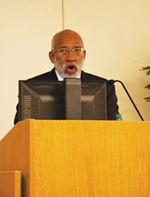Race in the age of Obama


Mike Wormley/Pioneer
Professor Roy Brooks of San Diego State University lectures about race on Nov. 3.
Racism in the age of the America’s first black president finds the country at a crossroads, said Professor Roy Brooks of San Diego State University in a speech on campus Nov. 3.
Brooks said the U.S. is in a post Civil Rights period that is marked by contrasting racial dynamics. On the one hand, we have racial success; on the other hand, we have racial despair.
“Conservatives argue that the best way is not to define it at all,” Brooks said. “As we have seen the success of many African Americans, many people believe that we do not have a race problem anymore.
Brooks said this is incorrect.
“The problem lies in cases like teenage pregnancy, the linkage of blacks and crimes, hypersensivity to racial issues, and the lack of educational ambitions,” Brooks said.
He believes that some of the statistics are misleading, explaining that they do not give a complete picture to the case.
Liberals, on the other hand, insist that Americans still have a race problem. They define the problem less in terms of individual racism as in terms of institutional and societal racism and racial stereotyping.
In Brook’s book, entitled “Racial Justice in the Age of Obama,” he argues that the conception of both liberals and conservatives is wrong.
Conservatives are wrong if they believe there is a level playing field on which members of every race can compete equally.
Brooks supports his point of view with figures that show the income disparity among whites, blacks and Hispanics. The figure proves that whites get paid more than blacks and Hispanics.
As for liberals, Brooks said, they need to recognize that racism has declined since the end of the Civil Rights movement. He cited the fact that 43 percent of whites voted for a black president in 2008 whereas in the 1970s no one even thought that a black president could be elected.
However, Brooks explained, despite the decline of racism, the racial differentials and resources between blacks and whites remain constant.
“The American race problem is caused by resource disparity between whites and blacks,’’ Brooks said.
This involves financial capital deficiencies such as income, human capital deficiencies such as education and skills, and social capital deficiencies; such as the ability to get things done in society.
One student said Brooks opened her eyes to some new ideas.
“I have read many books that Brooks wrote and this book is my favorite,” said Rand Alzubi, a sophomore accounting major.
“I knew we had a hidden racial issue, but I never thought about it the way Brooks explains it.”
Alzubi said she started reading Brooks’ books about two years ago because a friend gave her his book as a gift and she liked it.
To contact Hala Aljazzazi, email onlineeditor@occc.edu.